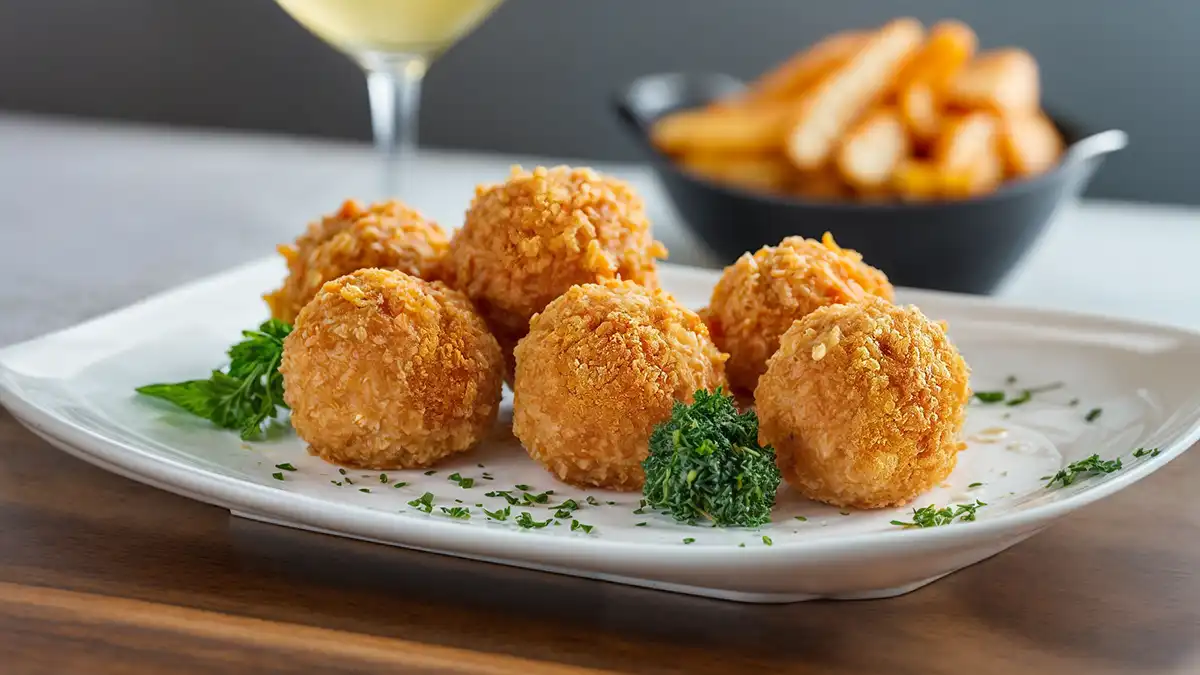Crab balls recipe enthusiasts, dive into a delicious seafood adventure with this culinary delight that brings the taste of the ocean right to your kitchen. Celebrated for their crispy exterior and succulent, flavorful interior, crab balls are the perfect addition to elevate any gathering, from casual get-togethers to elegant parties.
Table of Contents
| Section | Content |
|---|---|
| Introduction | Explore the allure of crab balls, including their history, essential ingredients, and initial preparation steps. |
| Gathering Tools and Ingredients | Detailing necessary kitchen tools and ingredients, preparation techniques, and linking to related recipes. |
| Mastering Cooking Techniques | Instructions on frying and baking crab balls, including step-by-step guidance and cooking tips. |
| Creative Variations and Serving | Exploring recipe variations, additional ingredients, and various serving suggestions with appropriate links. |
| Storing and Reheating Crab Balls | Best practices for storing and reheating to maintain deliciousness |
| FAQs | Answers to frequently asked questions about crab balls recipe. |
A Pinch of History and Regional Twists
Crab balls recipe, similar to the cherished crab cakes, have deep roots in seafood-rich regions like Maryland and the Chesapeake Bay. Here, the art of blending fresh crab meat with various ingredients and crafting them into bite-sized delights has been perfected over generations. As you delve into recipes, you’ll find regional twists that incorporate local flavors and techniques, making each version uniquely delightful.
The Importance of Select Ingredients
The secret to a standout crab balls recipe is top-quality ingredients. Fresh, succulent crab meat is crucial—it can make or break the dish. The right seasonings and binders enhance flavor and ensure the perfect texture: crispy outside, tender and moist inside.
Table: Essential Ingredients for Exquisite Crab Balls
| Ingredient | Role in Recipe | Common Variations |
|---|---|---|
| Crab Meat | Main component, provides flavor | Jumbo lump, backfin, claw |
| Breadcrumbs | Binder, adds texture | Panko, traditional, gluten-free options |
| Eggs | Helps bind the mixture together | Whole eggs, egg whites for lighter versions |
| Seasonings | Enhances flavor | Old Bay, parsley, mustard, cajun spices |
Gathering Your Kitchen Arsenal and Ingredients for Your Crab Balls Recipe
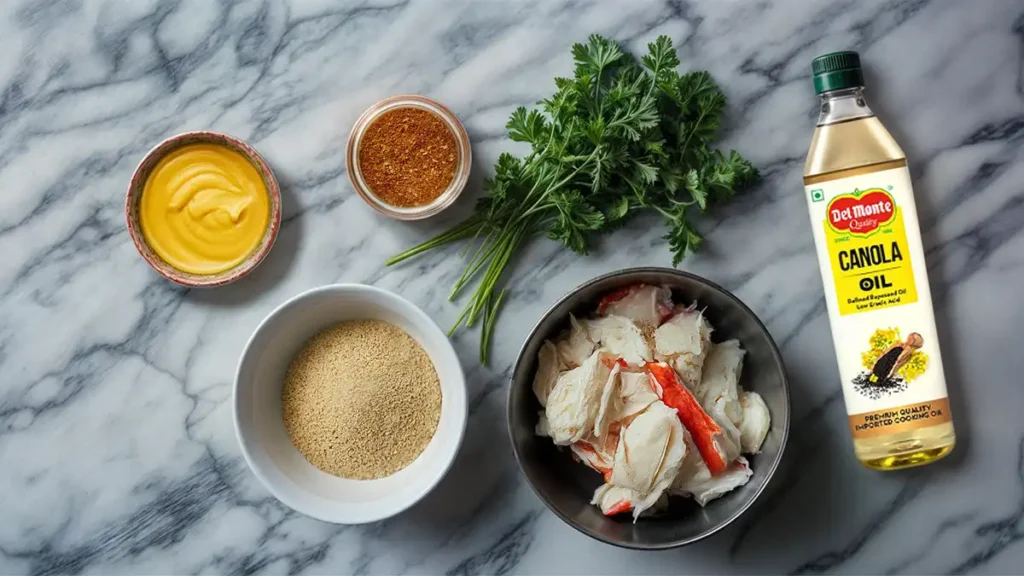
Before shaping and cooking, ensure your kitchen is stocked with the right tools and ingredients. The right equipment, from mixing bowls to baking sheets, makes a big difference. Each item plays a pivotal role in the process, ensuring your recipe turns out perfect every time.
Kitchen Tools You’ll Need
- Mixing bowls: For combining the crab meat and other ingredients.
- Measuring spoons and cups: Precision is key to balancing flavors perfectly.
- Baking sheet or frying pan: Depending on whether you’re baking or frying your crab balls.
- Parchment paper or non-stick spray: Essential for ensuring your crab balls don’t stick.
- Cookie scoop or spoon: For forming perfectly uniform crab balls.
Key Ingredients List
- Crab meat: The star of the show. Whether you opt for jumbo lump or a more budget-friendly option like backfin, freshness is crucial.
- Binding agents: Like breadcrumbs or crackers, which help hold the crab balls together.
- Seasonings: Enhancers like Old Bay, parsley, and mustard play a significant role in defining the flavor profile.
Preparing the Ingredients
With your tools ready, let’s prep the ingredients. Freshness is key, so ensure your crab meat is fresh or well-thawed. For homemade breadcrumbs, pulse fresh bread in a food processor for a crisp texture.
Combining Ingredients
Mixing your ingredients correctly is crucial. Start by gently folding your crab meat with the seasonings to avoid breaking up those delicate lumps of crab too much. Then, gradually integrate your binding agents to form a cohesive mixture ready for shaping.
If you’re looking for another recipe that pairs well with seafood, check out our Crab Brûlée recipe. It’s another fantastic way to enjoy the richness of crab in a unique and delightful dish!
Mastering the Cooking Techniques for Crab Balls Recipe
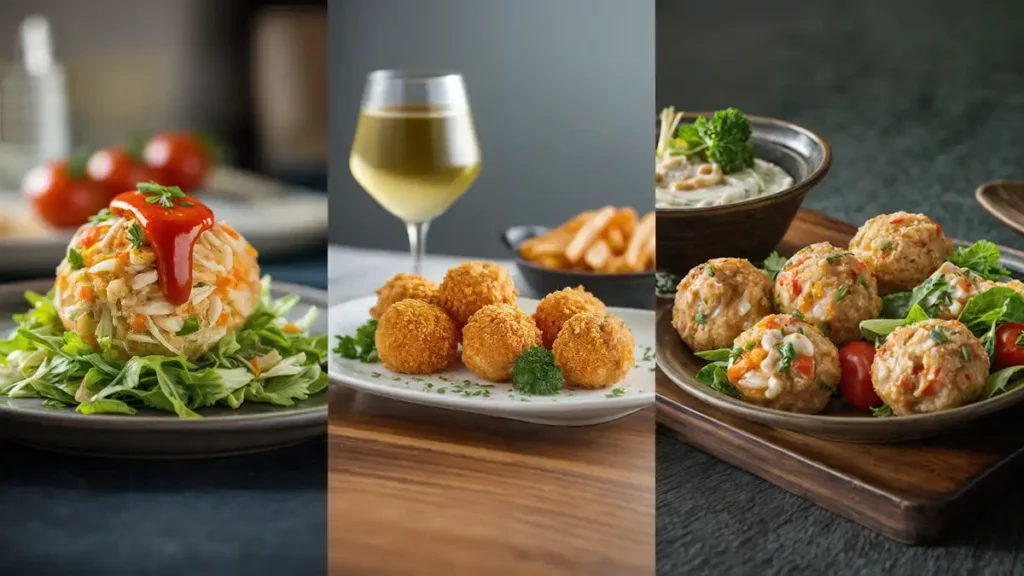
Crafting the perfect crab ball means choosing the right cooking method for a golden crust and moist, flavorful inside. We’ll explore frying and baking, each offering unique textures and flavors. Choosing the right technique can elevate your crab balls from good to unforgettable.
Frying Crab Balls
- Equipment Needed: Deep fryer or a deep skillet.
- Oil Type: Opt for a neutral oil with a high smoke point, like vegetable or canola oil.
- Temperature: The oil should be heated to around 350°F (177°C) for the best results.
- Cooking Time: Fry the crab balls in small batches for about 3 to 5 minutes until they are golden brown and crispy.
Pro Tip: Always use a thermometer to check the oil’s temperature to ensure it’s just right, preventing those crab balls from absorbing too much oil and becoming greasy.
Baking Crab Balls
- Equipment Needed: Oven preheated to 400°F (200°C) and a baking sheet.
- Preparation: Line the baking sheet with parchment paper or lightly grease it to prevent sticking.
- Cooking Time: Bake for about 10-15 minutes, turning once until they are evenly golden and crispy.
Health Tip: Baking is a healthier alternative to frying, reducing the oil content while still achieving a satisfying crunch. Learn more about the benefits of baking over frying here.
Step-by-Step Cooking Instructions
- Prepare Your Cooking Station: Whether frying or baking, set up your station with all necessary tools and ingredients within easy reach.
- Shape the Crab Mixture: Using a scoop or spoon, shape the mixture into uniform balls. This ensures even cooking no matter the method you choose.
- Cook with Care: Place the crab balls gently into the oil or on the baking sheet. If frying, do not overcrowd the pan to allow for even cooking and easy turning.
- Monitor Closely: Keep an eye on the crab balls as they cook. They should turn a beautiful golden brown when done.
- Rest and Serve: Once cooked, let them rest on a paper towel-lined plate or cooling rack for a few minutes to drain any excess oil. Serve hot with your choice of dipping sauces.
For those looking to complement their meal with another seafood delight, consider checking out our Jamaican Beef Patty recipe. This dish offers a spicy kick that pairs wonderfully with the mild flavors of crab balls.
Tutorial: How to Cook Crab Balls Recipe
For a visual and step-by-step guide to making and cooking crab balls, check out this helpful tutorial video:
Creative Variations and Serving Ideas for Crab Balls Recipe
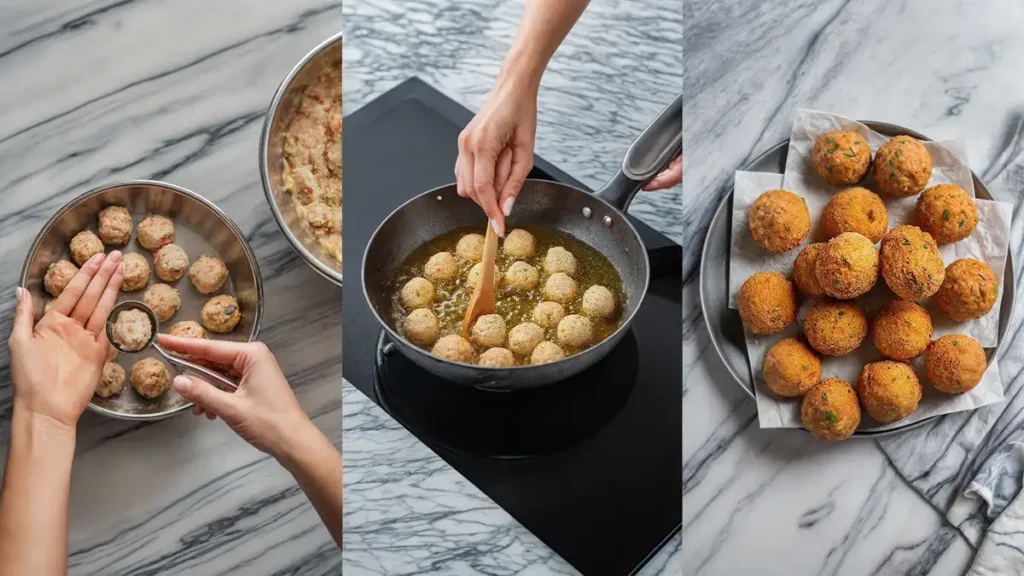
Once you’ve mastered the basic crab ball recipe, why not add some creative twists? Experimenting with different ingredients can transform the traditional crab ball into something exciting and new each time.
Adding Extra Ingredients
- Vegetables: Fold finely chopped onions, bell peppers, or celery into the crab mix for a crunchy texture and fresh flavor.
- Cheese: Incorporate some shredded cheddar or a sprinkle of parmesan to add a cheesy, savory depth.
- Spices: For those who like it hot, a dash of cayenne pepper or a splash of hot sauce can kick things up a notch.
Table: Flavor Variations for Crab Balls
| Ingredient | Effect on Flavor | Suggested Combination |
|---|---|---|
| Bell Peppers | Adds sweetness and crunch | Combine with celery for a fresh, vibrant mix |
| Cheddar Cheese | Richness and depth | Pair with a mild hot sauce for a spicy contrast |
| Cayenne Pepper | Spicy kick | Use with lemon zest for a spicy-citrus balance |
Dipping Sauces
A great dip can elevate your crab balls from delicious to divine. Here are a few ideas:
- Classic Tartar Sauce: Perfect for those who love tradition.
- Spicy Remoulade: Adds a zesty flair to each bite.
- Garlic Aioli: For a rich, creamy garlic punch.
Consider exploring these additional recipes for sauce inspirations:
- Leche de Tigre Recipe: A zesty, citrus-based Peruvian sauce that pairs wonderfully with seafood.
- Raspberry Chipotle Sauce: A sweet and spicy option that’s a surefire crowd-pleaser.
Serving Suggestions
Crab balls make an excellent addition to various settings, from casual snacks to formal appetizers.
Pairings
- Wine: A crisp white wine like Sauvignon Blanc complements the delicate flavors of crab.
- Beer: Light lagers or pilsners can cleanse the palate between bites.
Presentation Tips
- Plating: Serve on a bed of lettuce with lemon wedges and a side of your chosen sauce.
- Garnish: A sprinkle of chopped parsley or chives adds a pop of color and freshness.
For those interested in more seafood dishes, check out these tasty options:
- Crawfish Pie Recipe: Another delightful seafood treat.
- Smoked Old Fashioned Recipe: A smoky twist on a classic cocktail that pairs beautifully with seafood appetizers.
Storing and Reheating Crab Balls with Expert Tips
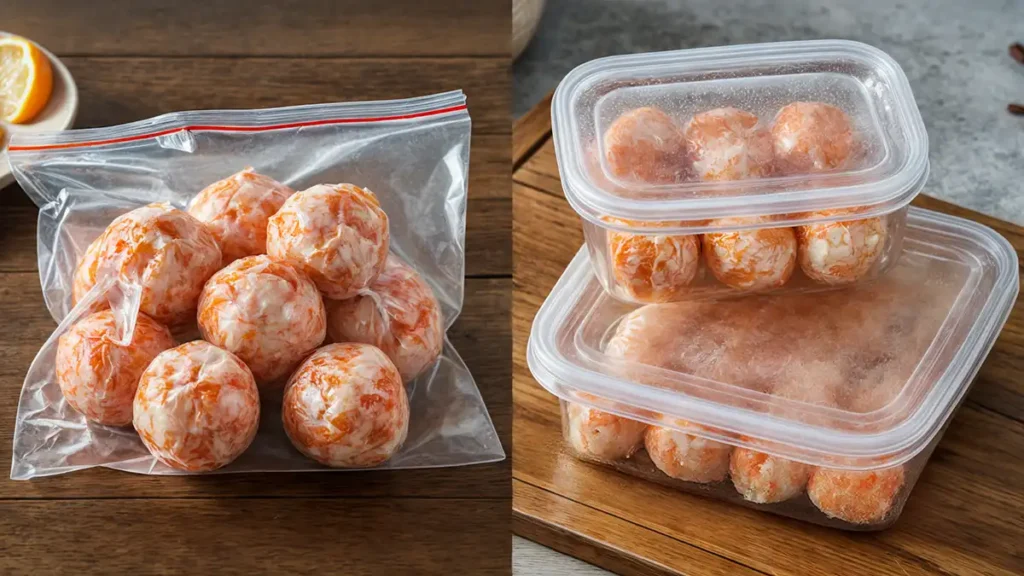
To ensure your crab balls stay delicious even after storing and reheating, it’s important to follow best practices. Let’s dive into the best storage methods to perfect your crab ball experience.
Storing Your Crab Balls
- Refrigeration: Place cooled crab balls in an airtight container. They can be refrigerated for up to 3 days.
- Freezing: For longer storage, freeze them on a baking sheet before transferring to a freezer-safe bag. They can be stored for up to 3 months.
Reheating to Perfection
- Oven Method: Preheat your oven to 350°F (175°C). Place crab balls on a baking sheet and heat for 10-15 minutes until heated through.
- Air Fryer Method: For a quick and crispy method, reheat them in an air fryer at 350°F for about 5-8 minutes.
FAQs About Crab Balls Recipe
What are crab balls made of?
Crab balls primarily consist of crab meat, binding ingredients like breadcrumbs or crackers, and various seasonings to enhance the flavor. They can be fried or baked to golden perfection.
What goes with crab balls?
Crab balls pair wonderfully with dipping sauces like tartar sauce, remoulade, or a spicy aioli. They also go well with sides such as coleslaw, fresh salads, or light pasta dishes.
How to cook frozen crab balls?
To cook frozen crab balls, preheat your oven to 400°F (200°C). Place them on a baking sheet lined with parchment paper and bake for 15-20 minutes until they are heated through and crispy.
Why do you soak crab meat in milk?
Soaking crab meat in milk helps to tenderize the meat and remove any lingering fishy odors, enhancing its natural sweet flavor.
What are the best types of crab meat to use?
The best types of crab meat for making crab balls are jumbo lump for its impressive size and flavor, or backfin which offers a good balance of texture and value. Both provide the succulent taste essential for delicious crab balls.
Conclusion
We hope this guide helps you enjoy your crab balls to the fullest, whether freshly made or reheated. Don’t forget to experiment with different flavors and combinations to find your perfect match. If you have any more questions or need further tips, feel free to drop a comment below. Thank you for reading, and happy cooking!

